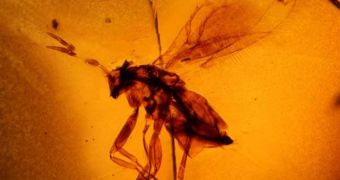Just recently, an international collaboration of scientists and archaeologists conducted a new expedition in Ethiopia, during which they discovered a wide array of prehistoric lifeforms, all of them trapped in amber. The 20 members of the expedition discovered 30 different arthropods solidified in the deposits, all of them belonging to about 13 families. Insects, spiders, fungus and spores were identified throughout the large blobs of amber, which researchers believed formed in what was millions of years ago an ancient tropical forest.
The newly found amber deposit is no less than 95 million years old, which puts it square in the middle of the Cretaceous Period. This was the last age on our planet that saw dinosaurs ruling the land and the seas, before the giant lizards were annihilated in the K-T extinction event, some 65 million years ago. This means that the newly discovered creatures and plants lived at the same time as the Tyrannosaurs Rex and the Velociraptor, alongside the massive sauropods. Details of the amazing finding are published in this week's issue of the esteemed journal Proceedings of the National Academy of Sciences (PNAS), LiveScience reports.
Experts have wondered for a long time when it was precisely that Cretaceous plants started blooming, developing and diversifying, and the clues contained within the large pieces of amber that were discovered could finally answer at least a part of those mysteries. At the time when the fossils formed, the entire landmass of the planet was very different from how we know it today. “Until now, we had discovered virtually no Cretaceous amber sites from the southern hemisphere's Gondwanan supercontinent. Significant Cretaceous amber deposits had been found primarily in North America and Eurasia,” American Museum of Natural History Division of Invertebrate Zoology expert Paul Nascimbene says.
“The first angiosperms, or flowering plants, appeared and diversified in the Cretaceous. Their rise to dominance drastically changed terrestrial ecosystems, and the Ethiopian amber deposit sheds light on this time of change,” University of Gottingen fellow researcher Alexander Schmidt adds. The amber itself is very peculiar, the experts explain, because it does not resemble the one produced by any other known species of plants. “The tree that produced the sap is still unknown, but the amber's chemistry is surprisingly very much like that of a group of more recent New World angiosperms called Hymenae. This amber could be from an early angiosperm or a previously-unknown conifer that is quite distinct from the other known Cretaceous amber-producing gymnosperms,” Nascimbene concludes.

 14 DAY TRIAL //
14 DAY TRIAL //